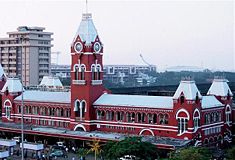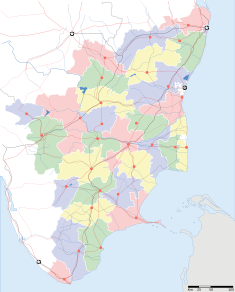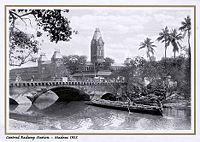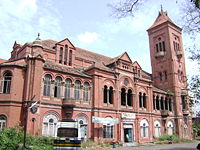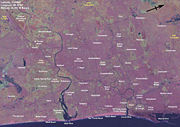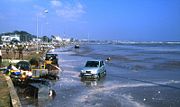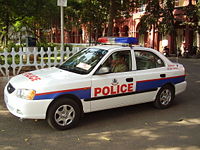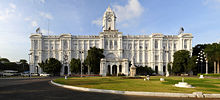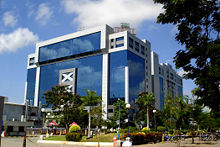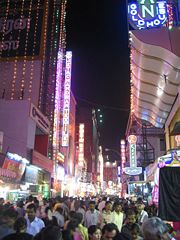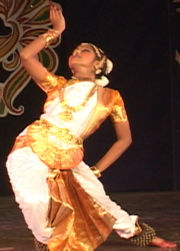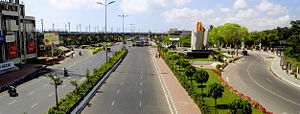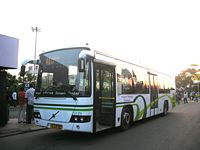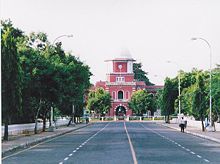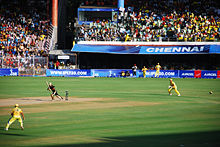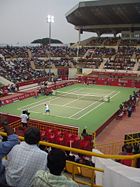Chennai
2008/9 Schools Wikipedia Selection. Related subjects: Asia; Asian Cities
| ?Chennai Tamil Nadu • India |
|
|
|
|
|
|
|
| Coordinates: | |
| Time zone | IST ( UTC+5:30) |
| Area • Metro • Elevation |
181.06 km² (70 sq mi) • 1,180 km² (456 sq mi) • 6 m (20 ft) |
| District(s) | • Chennai • Kanchipuram • Tiruvallur |
| Population • Density • Metro |
4.34 million ( 5th) (2001) • 24,418 /km² (63,242 /sq mi) • 7.5 million ( 4th) ( 2007) |
| Mayor | M. Subramaniam |
| Corporation Commissioner | Rajesh Lakhoni |
| Codes • Pincode • Telephone • UN/LOCODE • Vehicle |
• 600 xxx • +91 44 • INMAA • TN-01, 02, 03, 04, 05, 06, 07, 09, 10 |
| Website: www.chennaicorporation.com | |
|
|
|
Coordinates: Chennai (Tamil: சென்னை, formerly known as Madras , is the capital of the Indian state of Tamil Nadu. Located on the Coromandel Coast of the Bay of Bengal, Chennai has an estimated population of 7.5 million (2007), making it the fourth largest metropolitan city in India.
The city was established in the 17th century by the British, who developed it into a major urban centre and naval base. By the 20th century, it had become an important administrative centre, as the capital of the Madras Presidency.
Chennai's economy has a broad industrial base in the automobile, technology, hardware manufacturing, and healthcare industries. The city is home to much of India's automobile industry and is the country's second-largest exporter of Software, information technology ( IT) and information-technology-enabled services ( ITES), behind Bangalore .
The city is served by an international airport and two major ports; it is connected to the rest of the country by five national highways and two railway terminals. Thirty-five countries have consulates in Chennai.
Chennai hosts a large cultural event, the annual Madras Music Season, which includes performances by hundreds of artists. The city has a vibrant theatre scene and is an important centre for the Bharatanatyam, a classical dance form. The Tamil film industry, known as Kollywood, is based in the city; the soundtracks of the movies dominate its music scene. Chennai is known for its sport venues and hosts an Association of Tennis Professionals ( ATP) event, the Chennai Open. The city faces problems of water shortages, traffic congestion and air pollution. The state and local governments have undertaken initiatives such as the Veeranam project, Rainwater harvesting and the construction of mini-flyovers to address some of these problems.
Names
The name Chennai is an eponym, etymologically derived from Chennapattinam or Chennapattanam, the name of the town that grew up around Fort St. George, built by the British in 1640. There are different versions about the origin of the name. When the British landed here in 1639 A.D. it was said to be part of the empire of the Raja of Chandragiri. The British named it Chennapatnam after they acquired it from Chennappa Nayaka, a Vijayanagar chieftain. Gradually, the name was shortened to Chennai. The first instance of the use of the name Chennai is said to be in a sale deed dated August 1639 to Francis Day, an agent for the British where there is a reference to Chennaipattinam.
Although some believe Chennapattinam was named after the Chenna Kesava Perumal Temple, as the word Chenni in Tamil means face, and the temple was thought of as the face of the city.
The former name, Madras, is derived from Madraspattinam, a fishing village that lay to the north of Fort St. George. The origin of the name Madraspattinam is a subject of disagreement. One theory holds that the Portuguese, who arrived in the area in the 16th century, may have named the village Madre de Deus. However, historians believe that the village's name came from the once prominent Madeiros family (variously known as Madera or Madra in succeeding years), who had consecrated the Madre de Deus church in Santhome in 1575 (demolished in 1997). Another theory says that the village was named after an Islamic college (a madrasa) which was located in the area. After the British gained possession of the area in the 17th century, the two towns, Madraspattinam and Chennapattinam, eventually merged. The British referred to the united town as Madraspattinam, while the locals preferred to call it Chennapattinam.
The city was officially renamed Chennai in 1996, about the same time that many Indian cities were undergoing name changes. Madras was seen as a Portuguese name.
History
The region around Chennai has served as an important administrative, military, and economic centre since the 1st century. It has been ruled by various South Indian dynasties, notably the Pallava, the Chola, the Pandya, and Vijaynagar. The town of Mylapore, now part of Chennai, was once a major Pallavan port. The Portuguese arrived in 1522 and built a port called São Tomé after the Christian apostle, St Thomas, who is believed to have preached in the area between 52 and 70 CE. In 1612, the Dutch established themselves near Pulicat, just north of the city.
On 22 August 1639, Francis Day of the British East India Company bought a small strip of land on the Coromandel Coast from the Vijayanagara King, Peda Venkata Raya in Chandragiri. The region was ruled by Damerla Venkatapathy, the Nayak of Vandavasi. He granted the British permission to build a factory and warehouse for their trading enterprises. A year later, the British built Fort St George, which became the nucleus of the growing colonial city. In 1746, Fort St. George and Madras were captured by the French under General La Bourdonnais, the Governor of Mauritius, who plundered the town and its outlying villages. The British regained control in 1749 through the Treaty of Aix-la-Chapelle and fortified the town's fortress wall to withstand further attacks from the French and another looming threat, Hyder Ali, the Sultan of Mysore. By the late 18th century, the British had conquered most of the region around Tamil Nadu and the northern modern-day states of Andhra Pradesh and Karnataka, establishing the Madras Presidency with Madras as the capital. Under British rule, the city grew into a major urban centre and naval base.
With the advent of railways in India in the late 19th century, the thriving urban centre was connected to other important cities such as Bombay and Calcutta, promoting increased communication and trade with the hinterland. Madras was briefly under Portuguese and French rule during 16th & 18th century.
Madras was the only Indian city to be attacked by the Central Powers during World War I, when an oil depot was shelled by the German light cruiser SMS Emden on September 22, 1914, as it raided shipping lanes in the Indian Ocean, causing disruption to shipping. After India gained its independence in 1947, the city became the capital of Madras State, renamed the state of Tamil Nadu in 1969. The violent agitations of 1965 against the imposition of Hindi as the national language, marked a major shift in the political dynamics of the city and the whole state.
In 2004, an Indian Ocean tsunami lashed the shores of Chennai, killing many and permanently altering the coastline.
Geography and climate
Chennai is on the southeast coast of India in the northeast of Tamil Nadu on a flat coastal plain known as the Eastern Coastal Plains. Its average elevation is around 6.7 metres (20 ft), and its highest point is 60 m (200 ft). The Marina Beach runs for 12 km along the shoreline of the city. Two rivers meander through Chennai, the Cooum River (or Koovam) through the centre and the Adyar River to the south. A third river, the Kortalaiyar, flows through the northern fringes of the city before draining into the sea at Ennore. Adyar and Cooum rivers are heavily polluted with effluents and waste from domestic and commercial sources. The state government periodically removes silt and pollution from the Adyar, which is much less polluted than the Cooum. A protected estuary on the Adyar forms a natural habitat for several species of birds and animals. The Buckingham Canal, 4 km (3 miles) inland, runs parallel to the coast, linking the two rivers. The Otteri Nullah, an east-west stream, runs through north Chennai and meets the Buckingham Canal at Basin Bridge. Several lakes of varying size are located on the western fringes of the city. Red Hills, Sholavaram and Chembarambakkam Lake supply Chennai with potable water. Groundwater sources are becoming brackish.
Chennai's soil is mostly clay, shale and sandstone. Sandy areas are found along the river banks and coasts, such as Tiruvanmiyur, Adyar, Kottivakkam, Santhome, George Town, Tondiarpet and the rest of coastal Chennai. Here rainwater runoff percolates quickly through the soil. Clay underlies most of the city including T. Nagar, West Mambalam, Anna Nagar, Perambur and Virugambakkam. Areas of hard rock include Guindy, Velachery, Adambakkam and a part of Saidapet.
| Climate chart for Chennai | |||||||||||
|---|---|---|---|---|---|---|---|---|---|---|---|
| J | F | M | A | M | J | J | A | S | O | N | D |
|
36
30
20
|
10
31
20
|
7
33
22
|
15
35
26
|
26
39
28
|
37
38
27
|
91
36
26
|
116
35
26
|
119
34
26
|
306
32
24
|
355
30
22
|
138
29
21
|
| temperatures in °C precipitation totals in mm source: Nirvana Tour |
|||||||||||
|
Imperial conversion
|
|||||||||||
Chennai is divided into four parts: North, Central, South and West. North Chennai is primarily an industrial area. Central Chennai is the commercial heart of the city and includes an important business district, Parry's Corner. South Chennai and West Chennai, previously mostly residential, are fast becoming commercial, home to a growing number of information technology firms, financial companies and call centres. The city is expanding quickly along the Old Mahabalipuram Road and the Grand Southern Trunk Road ( GST Road) in the south and towards Ambattur, Koyambedu and Sriperumbdur in the west. Chennai is one of the few cities in the world that accommodates a national park, the Guindy National Park, within its limits.
Chennai lies on the thermal equator and is also coastal, which prevents extreme variation in seasonal temperature. For most of the year, the weather is hot and humid. The hottest part of the year is late May and early June, known locally as Agni Nakshatram ("fire star") or as Kathiri Veyyil, with maximum temperatures around 38–42 °C (100–107 °F). The coolest part of the year is January, with minimum temperatures around 19–20 °C (66–68 °F). The lowest temperature recorded is 15.8 °C (60.44 °F) and highest 45 °C (113 °F). The average annual rainfall is about 1,300 mm (51 inches). The city gets most of its seasonal rainfall from the north-east monsoon winds, from mid-September to mid-December. Cyclones in the Bay of Bengal sometimes hit the city. Highest annual rainfall recorded is 2,570 mm (101 in) in 2005. The most prevailing winds in Chennai are the South-westerly between May and September and the North-easterly during the rest of the year.
Administration and utility services
| City officials, as of September 2007 | ||
| Mayor | Ma. Subramanian | |
| Deputy Mayor | R. Sathya Bama | |
| Corporation Commissioner | Rajesh Lakhoni | |
| Commissioner of Police | R. Sekar | |
Chennai city is governed by the Corporation of Chennai, consisting of 155 councillors who represent 155 wards and are directly elected by the city's residents. From among themselves, the councillors elect a mayor and a deputy mayor who preside over about six standing committees. Chennai, the capital of Tamil Nadu state, houses the state executive and legislative headquarters primarily in the Secretariat Buildings on the Fort St George campus but also in many other buildings scattered around the city. The Madras High Court, whose jurisdiction extends across Tamil Nadu and Puducherry, is the highest judicial authority in the state and is also in the city. Chennai has three parliamentary constituencies—Chennai North, Chennai Central and Chennai South—and elects 18 Members of the Legislative Assembly ( MLAs) to the state legislature.
The metropolitan region of Chennai covers many suburbs that are part of Kanchipuram and Thiruvallur districts. The larger suburbs are governed by town municipalities, and the smaller ones are governed by town councils called panchayats. While the city covers an area of 174 km² (67 mi²), the metropolitan area is spread over 1,189 km² (458 mi²). The Chennai Metropolitan Development Authority ( CMDA) has drafted a Second Master Plan that aims to develop satellite townships around the city. Contiguous satellite towns include Mahabalipuram to the south, Chengalpattu and Maraimalai Nagar to the southwest, and Kanchipuram town, Sriperumpudur, Tiruvallur and Arakkonam to the west.
The Greater Chennai Police department, a division of the Tamil Nadu Police, is the law enforcement agency in the city. The city police force is headed by a commissioner of police, and administrative control rests with the Tamil Nadu Home Ministry. The department consists of 36 subdivisions with a total of 121 police stations, of which 15 are ISO 9001:2000 certified. The city's traffic is managed by the Chennai City Traffic Police (CCTP). The Metropolitan suburbs are policed by the Chennai Metropolitan Police, and outer district areas are policed by the Kanchipuram and Thiruvallur police departments.
The Corporation of Chennai and municipalities of the suburbs provide civic services. Garbage in most zones is handled by JBM Fanalca Environment Management, a private company, and by the Chennai Corporation in the other zones. Water supply and sewage treatment are handled by the Metropolitan Water Supply and Sewage Board, popularly referred to as Metro Water. Electricity is supplied by the Tamil Nadu Electricity Board. The city's telephone service is provided by six mobile phone companies and four landline companies, which also provide broadband Internet access, along with Sify and Hathway.
Historically, Chennai has relied on annual monsoon rains to replenish water reservoirs, as no major rivers flow through the area. Steadily growing in population, the city has faced water supply shortages, and its ground water levels have been depleted. An earlier Veeranam Lake project failed to solve the city's water problems, but the New Veeranam project, which became operational in September 2004, has greatly reduced dependency on distant sources. In recent years, heavy and consistent monsoon rains and rainwater harvesting (RWH) by Chennai Metrowater at its Anna Nagar Rain Centre have significantly reduced water shortages. Moreover, newer projects like the Telugu Ganga project that bring water from water-surplus rivers like the Krishna River in Andhra Pradesh have eased water shortages. The city is constructing sea water desalination plants to further increase the water supply.
Economy
Chennai has a diversified economic base anchored by the automobile, software services, hardware manufacturing, healthcare and financial services industries. As of 2000, the city's total personal income was Rs. 12,488.83 crores, making up 10.9% of the total income of Tamil Nadu. In 2001, the total workforce in Chennai was about 1.5 million, which was 31.79% of its population. According to the 1991 census, most of the city's workforce was involved in trade (25.65%), manufacturing (23.52%), transportation (10.72%), construction (6.3%) and other services (31.8%). Chennai metropolitan area accounts for over 75% of the sales tax revenue in the state.
The city is base to around 30% of India's automobile industry and 35% of its auto components industry. A large number of automotive companies including Hyundai, Ford, BMW, Mitsubishi, The TVS Group ( TVS), Ashok Leyland, Nissan- Renault, TI Cycles of India, TAFE Tractors, Royal Enfield, Caterpillar, Caparo and Madras Rubber Factory ( MRF), have manufacturing plants in and around Chennai. The Heavy Vehicles Factory at Avadi produces military vehicles, including India's main battle tank: Arjun MBT. The Integral Coach Factory manufactures railway coaches and other rolling stock for Indian Railways. This very industrial expanse has given the name to Chennai as being the "Detroit of Southern Asia". The Ambattur-Padi industrial zone houses many textile manufacturers, and an SEZ for apparel and footwear manufacture has been set up in the southern suburbs of the city. Chennai contributes more than 50% of India's leather exports.
The city is an electronics manufacturing hub where multinational corporations like Dell, Nokia, Motorola, Samsung, Flextronics and Foxconn have set up electronics and hardware manufacturing plants, mainly in the Sriperumbudur Special Economic Zone ( SEZ). Many software and software services companies have development centres in Chennai, which contributed 14% of India's total software exports of Rs.144,214 crores during 2006–07, making it the second-largest exporter of software in the country, behind Bangalore. Prominent financial institutions, including the World Bank, HSBC, Citi bank have back office operations in the city. Chennai is home to three large national level commercial banks and many state level co-operative banks, finance and insurance companies. Some of India's well-known healthcare institutions such as Apollo Hospitals (the largest private healthcare provider in Asia), Sankara Nethralaya and Sri Ramachandra Medical Centre are based in the city, making it one of the preferred destinations for medical tourists from across the globe. Telecom giants Ericsson and Alcatel-Lucent, pharmaceuticals giant Pfizer and chemicals giant Dow Chemicals have research and development facilities in Chennai. TICEL bio-tech park and Golden Jubilee bio-tech park at Siruseri house biotechnology companies and laboratories. Chennai has a fully computerised stock exchange called the Madras Stock Exchange.
Demographics
A resident of Chennai is called a Chennaiite. As of 2001, Chennai city had a population of 4.34 million, while the total metropolitan population was 7.04 million. The estimated metropolitan population in 2006 is 4.5 million. In 2001, the population density in the city was 24,682 per km² (9,534 per mi²), while the population density of the metropolitan area was 5,922 per km² (2,287 mi²), making it one of the most densely populated cities in the world. The sex ratio is 951 females for every 1,000 males, slightly higher than the national average of 934. The average literacy rate is 80.14%, much higher than the national average of 64.5%. The city has the fourth highest population of slum dwellers among major cities in India, with about 820,000 people (18.6% of its population) living in slum conditions. This number represents about 5% of the total slum population of India. In 2005, the crime rate in the city was 313.3 per 100,000 people, accounting for 6.2% of all crimes reported in major cities in India. The number of crimes in the city showed a significant increase of 61.8% from 2004.
The majority of the population in Chennai are Tamilians and Tamil is the primary language spoken in Chennai. English is widely spoken especially in business, education and white collar professions. Sizeable Telugu and Malayalee communities live in the city. Chennai also has a large migrant population, who come from other parts of Tamil Nadu and the rest of the country. As of 2001, out of the 937,000 migrants (21.57% of its population) in the city, 74.5% were from other parts of the state, 23.8% were from rest of India and 1.7% were from outside the country. According to the 2001 census, Hindus constitute about 82.27% of the city's population, and Muslims (8.37%), Christians (7.63%) and Jains (1.05%) are other major religious groups.
Culture
Chennai's culture reflects its diverse population. The city is known for its classical dance shows and Hindu temples. Every December, Chennai holds a five-week long Music Season celebrating the 1927 opening of the Madras Music Academy. It features performances (kutcheries) of traditional Carnatic music by hundreds of artists in and around the city. An arts festival called the Chennai Sangamam, which showcases various arts of Tamil Nadu is held in January every year. Chennai is also known for Bharatanatyam, a classical dance form that originated in Tamil Nadu. An important cultural centre for Bharatanatyam is Kalakshetra, on the beach in the south of the city.
Chennai is the base for the large Tamil movie industry, dubbed Kollywood after Kodambakkam, home to most of the movie studios. The industry makes more than 150 Tamil movies a year, and its soundtracks dominate the city's music. Chennai's theatres stage many Tamil plays; political satire, slapstick comedy, history, mythology and drama are among the popular genres. English plays are also staged in the city.
Among Chennai's festivals, Pongal, celebrated over five days in January, is the most important. Tamil New Year's Day, signifying the beginning of the Tamil year, usually falls on April 14. Almost all major religious festivals such as Deepavali, Eid and Christmas are celebrated in Chennai. Tamil cuisine in Chennai includes vegetarian and non-vegetarian dishes. Many of the city's restaurants offer light meals or tiffin, which usually include rice-based dishes like pongal, dosai, idli and vadai, served with steaming hot filter coffee.
Transport
The Chennai International Airport, comprising the Anna International Airport and the Kamaraj Domestic Airport, handles domestic as well as international flights and is the third busiest airport in India. The city is connected to major hubs in South Asia, South East Asia, the Middle East, Europe and North America through more than 30 national and international carriers. The airport is the second busiest cargo terminus in the country. The existing airport is undergoing further modernisation and expansion, and a new greenfield airport is to be constructed at an estimated cost of Rs 2,000 crore in Sriperumbudur.
The city is served by two major ports, Chennai Port, one of the largest artificial ports, and Ennore Port. The Chennai port is India's second busiest container hub, handling automobiles, motorcycles and general industrial cargo. The Ennore Port handles cargo such as coal, ore and other bulk and rock mineral products. A smaller harbour at Royapuram is used by local fishing boats and trawlers.
Chennai is well connected to other parts of India by road and rail. Five major national highways radiate outward towards Mumbai, Kolkata, Trichy, Tiruvallur and Pondicherry. The Chennai Mofussil Bus Terminus ( CMBT), the terminus for all intercity buses from Chennai, is the largest bus station in Asia. Seven government-owned transport corporations operate inter-city and inter-state bus services. Many private inter-city and inter-state bus companies also operate services to and from Chennai.
The city has two main railway terminals. Chennai Central station, the city's largest, provides access to trains to major cities like Mumbai, Kolkata, Bangalore, Delhi, Hyderabad, Kochi, Thiruvananthapuram and Coimbatore as well as to smaller towns across India. Chennai Egmore is a terminus for trains traveling primarily within Tamil Nadu; it also handles a few inter-state trains.
Buses, trains, and auto rickshaws are the most common form of public transport within the city.
The Chennai suburban railway network consists of four broad gauge rail sectors terminating at two locations in the city, namely Chennai Central and Chennai Beach. Regular services are offered in the following sectors from these terminii: Chennai Central/ Chennai Beach - Arakkonam - Tiruttani, Chennai Central/ Chennai Beach – Gummidipoondi - Sullurpeta and Chennai Beach – Tambaram - Chengalpattu - Tirumalpur( Kanchipuram). The fourth sector is an elevated Mass Rapid Transit System ( MRTS) which links Chennai Beach to Velachery and is interlinked with the remaining rail network. The city has plans for an underground Metro.
The Metropolitan Transport Corporation ( MTC) runs an extensive city bus system consisting of 3,084 buses on 626 routes and transports an estimated 4.03 million passengers daily. Vans, popularly known as Maxi Cabs and 'share' auto rickshaws ply many routes in the city and provide an alternative to buses. Metered call taxis, tourist taxis and auto rickshaws are also available on hire. Chennai's transportation infrastructure provides coverage and connectivity, but growing use has caused traffic congestion and pollution. The government has tried to address these problems by constructing flyovers at major intersections, starting with the Gemini flyover, built in 1973 over the most important arterial road, Anna Salai.
Education
Schools in Chennai are either run publicly by the Tamil Nadu government or privately, some with financial aid from the government. The medium of education is either English or Tamil. Most schools are affiliated with the Tamil Nadu State Board, the Matriculation Board or the Central Board of Secondary Education (CBSE). A few schools are affiliated with the Indian Certificate of Secondary Education (ICSE) board, Anglo-Indian board or the Montessori system. Schooling begins at the age of three with two years of kindergarten followed by ten years of primary and secondary education. Students then need to complete two years of higher secondary education in either science or commerce before being eligible for college education in a general or professional field of study. There are 1,389 schools in the city, out of which 731 are primary, 232 are secondary and 426 are higher secondary schools.
The Indian Institute of Technology Madras (IIT Madras) and Anna University are two well known centres for engineering education in the city; most city colleges that offer engineering programs are affiliated with Anna University. Madras Medical College (MMC), Stanley Medical College (SMC), Kilpauk Medical College and Sri Ramachandra Medical College and Research Institute (SRMC) are the notable medical colleges in Chennai.
Colleges for science, arts and commerce degrees are typically affiliated with the University of Madras, which has three campuses in the city; some colleges such as Madras Christian College, Loyola College and The New College are autonomous. Research institutions like the Central Leather Research Institute (CLRI), the Central Electronics Engineering Research Institute (CEERI) and the Institute for Financial Management and Research (IFMR) are in the city. The Connemara Public Library is one of four National Depository Centres in India that receive a copy of all newspapers and books published in India. It has been declared a UNESCO information centre.
Sports
Cricket is the most popular sport in Chennai. The M.A. Chidambaram Stadium (MAC) in Chepauk is one of the oldest cricket stadiums in India. The Chemplast Cricket Ground on the IIT Madras campus is another important venue hosting first class matches. Prominent cricketers from the city include former Test-captains S. Venkataraghavan and Kris Srikkanth. A cricket fast bowling academy, the MRF Pace Foundation, whose coaches include Dennis Lillee, is based in Chennai. Chennai is home to the Indian Premier League cricket team, the Chennai Super Kings. Chennai is also home to the Indian Cricket League team, the Chennai Superstars, who won the first ever ICL 20s championship and the ICL Domestic 50s.
The Mayor Radhakrishnan Stadium is regarded by the International Hockey Federation as one of the best in the world for its state-of-the-art infrastructure. The city is home to a Premier Hockey League ( PHL) team, the Chennai Veerans, and has hosted many hockey tournaments such as the Asia Cup and the Men's Champions Trophy.
Chennai has produced popular tennis players such as Vijay Amritraj and Ramesh Krishnan and is host to an Association of Tennis Professionals (ATP) event, the Chennai Open. Football and athletic competitions are held at the Jawaharlal Nehru Stadium, which also houses a multi-purpose indoor complex for competition in volleyball, basketball and table tennis. Water sports are played in the Velachery Aquatic Complex. Chennai was the venue of the South Asian Games (SAF Games) in 1995.
Auto racing in India has been closely connected with Chennai since its beginnings shortly after independence. Motor racing events are held on a special purpose track in Irungattukottai, Sriperumbudur, which has also been the venue for several international competitions. Horse racing is held at the Guindy Race Course, while rowing competitions are hosted at the Madras Boat Club. The city has two 18-hole golf courses, the Cosmopolitan Club and the Gymkhana Club, both established in the late nineteenth century. Viswanathan Anand, the chess World champion and the world's top ranked chess player as of October 2007, grew up in Chennai.
Other athletes of repute from Chennai include table tennis players Sharath Kamal and two-time world carrom champion, Maria Irudayam. The city has a rugby union team called the Chennai Cheetahs.
Sister cities
 Denver, Colorado, United States
Denver, Colorado, United States San Antonio, Texas, United States, since February 2008
San Antonio, Texas, United States, since February 2008 Frankfurt, Germany, since 2005
Frankfurt, Germany, since 2005 Volgograd, Russia, since 1966
Volgograd, Russia, since 1966
